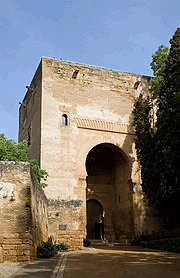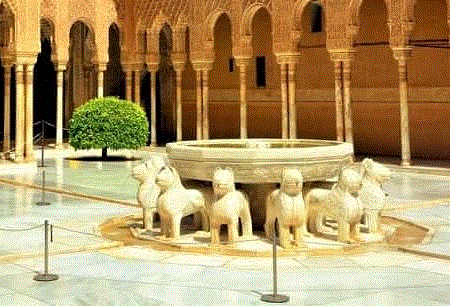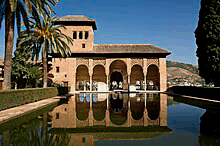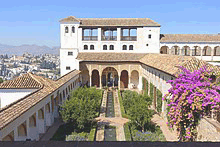
Nathalie Mignotte
Subject – “Gardens of the Alhambra & Generalife, Granada”
Our first evening talk of the 2023/4 season saw a gathering of 30 members and guests to greet Natalie Mignotte, who gave us interesting perspectives on the influences of history, geology, climate and faith on the creation of the gardens of Granada’s Alhambra Palace.
We learned that the name Alhambra means “red fortress”, and initially it was built in the mid-14th century as an Islamic military stronghold. A key point to note is that Granada is in the foothills of an area dominated by the Sierra Nevada mountains.
The Alhambra itself is perched high above the city. Seasonal temperature differences can therefore be extreme, with dry summer heat, and often cold temperatures in winter months. These combinations enable us to understand the architectural, decorative and horticultural styles which dominate both the Alhambra itself and the Generalife palace – a palace constructed as a retreat for the elites and their families in the hot summer months.
Additionally, of course, the importance of water supply and irrigation was a key factor. Natalie showed images of the channels and shallow fountains embedded in the original Islamic structural designs in the palace, which enabled efficient use of water from the river Darro. These designs continue to maintain an efficient irrigation system today, feeding plants from below.
Scent ( Myrtle is a feature) rather than colour dominates the planting in the palace, as it does also in the Generalife. Additionally, the importance of the number four in Islam is reflected in courtyard shapes. Orange trees in square patterns allow for the creation of shade. A sense of a desire for control is reflected in perfectly arranged hedgerows. In addition, the colour green dominates – the colour of “Life” in Islam.

Highlights of Natalie’s talk included the Courtyard of the Lions. Its fountain is said to represent the heavenly garden of Islam. A large bowl sits on twelve lions, and underneath the base of the fountain run four water channels, symbolising the four rivers of paradise.
Another highlight was the Palacio del Partal. Here, arches of the Partal façade reflect in the rectangular pool and is said to allow the observer to look down in humility on this reflection of a building pointing to the heavens.

Moving from the Alhambra, we have the gardens of the Summer Palace, the Generalife. In summertime the court would move to this cooler area, higher up than the Alhambra palace and set amongst the trees of the Alhambra woods. Here there are plenty of open spaces (including allotments!). We have water features, lush gardens, ponds and long paths. Here, Magnolia Grandiflora makes its mark in autumn months.

A key feature of the Generalife is the Patio de la Acequia, with water shooting up forming silver arches above the plants and the rectangular pool. Here also the large courtyard also offers views over the city of Granada.
Natalie’s talk was entertaining and insightful, with her multi-dimensional exploration of these historic buildings and the dramatic landscape which influenced their garden designs.
